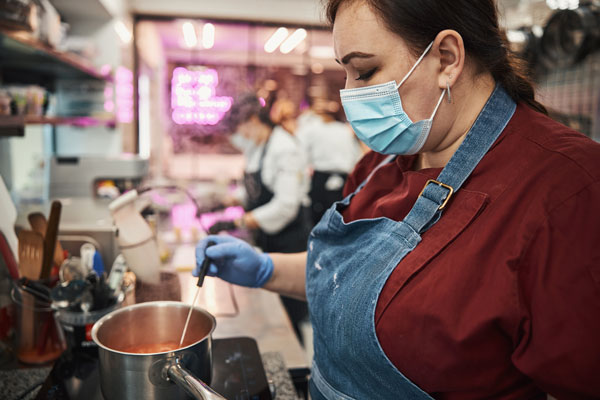Safely Shopping at Farmers’ Markets: A Food Safety Guide for Foodservice Operators and Chefs
Farmers’ markets are an appealing source of fresh, local, and seasonal ingredients for individuals and families across the United States. They also provide an excellent source of products for foodservice operators and chefs. Local farmers’ markets offer the opportunity to build relationships with local growers, reduce food miles, and bring fresh flavors to the plate. However, shopping at farmers’ markets for a commercial kitchen involves more than selecting the ripest tomato or the best watermelon; it requires a careful eye toward food safety.
One of the benefits of sourcing from farmers’ markets is the ability to speak directly with the people growing your food. Use this opportunity to ask about their food safety practices, including how the produce is harvested, washed, and stored; what the source of the water used for irrigation and washing is, and how livestock and produce areas are separated to avoid cross-contamination.
Further, inquire if the farmer participates in any food safety training or certification programs, such as the USDA’s Good Agricultural Practices (GAP) program. While GAP certification is not mandatory, it verifies that farms are following science-based guidelines to minimize the risk of microbial contamination during growing, harvesting, packing, and transporting food. Even if a grower is not certified, many adopt the practices, so it’s worth having an informed conversation.
…Many consumers think local means safer. And while you may know the grower and perhaps even the plot of land that a product comes from, it doesn’t necessarily mean that it is safer.
When selecting produce, keep an eye on the basic quality of the product, just as you would inspect the product if it were delivered from your broadline distributor. Is the skin or rind intact, with no visible mold, bruising, or decay? Observe the packaging and display areas. Are they relatively clean? Ensure that no produce is placed directly on the ground. Determine if there is a clear separation between raw animal products (e.g., eggs or meat) and produce to avoid cross-contamination. If dairy, eggs, or meats are sold, verify that they are held at safe temperatures with proper refrigeration or coolers.
After purchase, the safety of the product becomes your responsibility. Transport perishable items in coolers with ice packs or insulated containers. Always label and date products as you would with any other product in your business. Store items in separate containers to prevent cross-contamination between produce and proteins.
Although farmers’ markets may not offer the same level of documentation as large-scale distributors, traceability is still essential. Keep records of what was purchased, from whom, and on what date. Save receipts or take photos of vendor signs along with your purchases.
If your state or local regulations mandate that you use only approved or licensed sources, check with your local or state regulatory agency to ensure your farmers’ market purchases are compliant. Some local regulations require documentation for farm-sourced products used in commercial settings.
Last, but certainly not least, ensure your kitchen staff are trained on safe handling practices for locally sourced foods, which may not arrive in the same packaging or condition as commercial deliveries. Reinforce the importance of checking temperatures, washing all produce, and documenting sourcing. Develop a standard operating procedure for handling farmers’ market purchases or update your existing SOPs.
If you develop ongoing partnerships with local growers, consider encouraging them to pursue GAP certification or share their current food safety plans with you. Collaborating on food safety builds trust and contributes to a stronger local food system.
Many consumers think local means that the product is safer. And while you may know the grower and perhaps even the plot of land that a product comes from, it doesn’t necessarily mean that it is safer. By building relationships and applying the same due diligence to your local purchases as you do your other orders, you can bring the best of the farmers’ market to your menu with confidence and care. Risk Nothing.
READ MORE POSTS
Food Traceability in Foodservice Operations: An Essential, and Soon-to-be Required, Component of your Food Safety Plan
In June, I discussed the importance of having a solid food defense plan, and I provided you some resources for developing or strengthening your food defense plan. As I was writing those blogs, my mind kept turning toward food traceability. While they are distinctly different concepts, food traceability goes hand-in-hand with a food defense program. I would argue for your food defense plan to be effective, you must have an effective internal food traceability program, where you can trace the product back to the supplier (backward traceability), but also be able to trace the product from the supplier to the guest who was served the product (forward traceability).
Food Defense Plan Resources – at just the right price…
Earlier in the month, I discussed the importance of having a solid food defense plan in place for your foodservice operation. Even if the first version of your plan is not perfect, it is a start. Having plans down on paper will force you to think through the process and ensure the vulnerable points where opportunities exist for possible contamination within the operation are mitigated.
Don’t Turn a Blind Eye to Your Food Defense Practices
Late last week, as I mindlessly scrolled through Twitter, I ran across a Tweet suggesting the #IceCreamChallenge from summer 2019 was the real cause of the Coronavirus spread. Of course, the Tweet was made tongue in cheek, but it did cause me to reflect on that challenge, which had a short life on social media in the summer of 2019.
Salmonella and Listeria monocytogenes: Serious Threats to the Safety of Food
Earlier in the month, I mentioned the top microbial enemies we all face in foodservice operations, E. coli, Campylobacter, Salmonella, and Listeria monocytogenes. While we discussed E. coli and Campylobacter, we did not get around to discussing Salmonella or Listeria monocytogenes.










